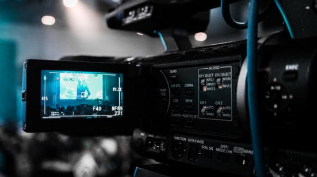6 Ideas to Inspire a Foundation Legacy Video

Ken Burns and Cokie Roberts said it best at the NCFP opening plenary – “It makes it more meaningful to carry on the legacy of the family when you know those family stories.” It was the perfect lead-in to our session on Preserving Donor and Family Legacy: New Tools and Techniques.
Our portion of the session focused on using video to capture stories for future generations. So many good questions and comments arose from the session that we wanted to share some ideas to inspire you to think about producing your own foundation’s legacy video.
1. A foundation’s video story doesn’t have to tell the whole story.
You family’s story or the story of your foundation’s history can feel overwhelming, especially when the foundation has had a rich and long life. But sharing these stories, particularly on video, does not have to include every detail. The specific dates, names and places are wonderful for print – whether in a hardcover book or on a timeline on a website. Use video for what it does best – capturing the emotions and feelings of those important stories – and the nuances of voice and expression that aren’t translated into print.
2. Focus on what makes a good story.
The elements of a good story have always included conflict, resolution, and strong characters we care about. Within your family foundation, you already have strong characters – family members that found a way to mobilize wealth and then wanted to give back. A big question that came up during the workshop was how do you know what information to include and what to leave out? The answer, when it comes to video, is to choose what led to change in some way. Think about the stories that were the turning points in a founder’s life – the challenges they faced and how they handled them. These are the moments that built character and changed the course of history and direction in someone’s life – or in an entire family. These stories become the pieces of wisdom that come out of on-camera interviews and the values that can be passed down to future generations.
3. It starts with a plan.
Before you press the camera’s record button, you want to spend a good deal of time in the first phase of video production – the pre-production phase. This is where you brainstorm with your trustees, board members and staff to determine the goals of your video – why you are creating this piece and what are the outcomes you’d like to see when it’s finished? (Inspire new members to come onto the board? Ensure we are following donor intent? Choose what works for your foundation.) This includes thinking about the most important stories to share and who would be best to share them on camera. When you’re deep in the filming or editing phase, you’ll want to refer back to these goals to make sure you achieve your intended result.
4. The gift of filming interviews goes both ways.
We inherently understand that having a recorded video interview of an elder person in your family is a gift to the future generations of the family who may never get to meet them or hear their stories in person. Having that archive of wisdom to tap into is an invaluable resource. In a New York Times article called, “The Stories That Bind Us,” Bruce Feiler found in his research that the families who were most resilient were the ones who knew about their own family history. But you may not realize that the simple act of being interviewed makes the interviewees feel acknowledged, appreciated and heard. They feel like they matter – and that validation is an intangible benefit that can’t be measured.
5. There’s something special about a shared experience.
Today’s younger generations are often interacting with media – posting, commenting and liking various “social” channels – but often doing this in a very singular way. Though watching a film about the history of your family or foundation may be a passive activity, when it’s viewed together with the entire family, there’s something unique about having this shared viewing experience. Rather than a fleeting activity, it’s an event that brings families together, taking them on an emotional journey they will remember for a long time to come.
6. Don’t wait.
We know that we need to capture these legacy stories before it’s too late and the older generations pass away. And yet most people put it off, thinking they’ll get to it someday, and then someday is too late. Find a way to get this done now, even if your founders have passed away. Find the person or people who knew them best and interview them on camera. Tie a legacy project into something else going on with your foundation – whether an anniversary date or a foundation milestone. Schedule it and put it on the calendar. The gift of future generations of your family foundation knowing their family’s history – from the people who helped create it – is priceless.
